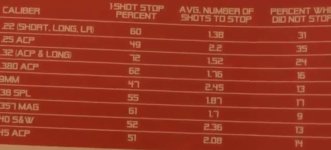Not all .380 ACP or .32 ACP handguns are equal. .380 ACP takes a much bigger hit in a shorter barrel than 9mm, and that’s even more the case with .32 ACP. In
The same goes for hollow point bullets. In both cases a hollow point has a fairly narrow velocity envelope where it will expand and still give decent penetration.
Here is a Walther PP with its 3.9” barrel and chambered in .32 ACP.
This are a pair of Hornady 60 gr XTP hollow points fired at right around 1000 fps. Penetration is about 11 1/2 to 11 5/8”, with the bullet getting pulled back a bit from maximum penetration.
Bullet expansion isn’t spectacular but it’s consistent and more importantly not so excessive that it significantly under penetrates.
The 90 gr XTP in .380 ACP doesn’t perform that much differently, with penetration in the 12-13” range and comparable expansion, but will do it in the slightly shorter 3.4” barrel of the PPK or PPK/S.
——
Now folks might choose to make a huge deal of the above .32 ACP bullets coming up 1/2” short of the FBI minimum standard. But that’s a bit of a red herring. Armed citizens are not shooting at fleeing felons, shooting through barriers, or shooting at other than face to face aspect angles as all of those things most often either start to diminish or entirely remove the presence of an imminent threat.
Folks might also indicate the larger .380 diameter and the comparably larger expanded diameter compared to .32 ACP makes a difference. Well…maybe. You also have to consider that the .32 ACP has much less recoil and in comparable pistols can be fired much faster with greater accuracy, and in comparable pistols the .32 ACP offers an extra round.
In other words, are two .380 ACP bullets more effective than three .32 ACP bullets fired in the same limited time frame? It’s 50% more wound tracks and 50% more chance of getting a cardio pulmonary or CNS hit.






